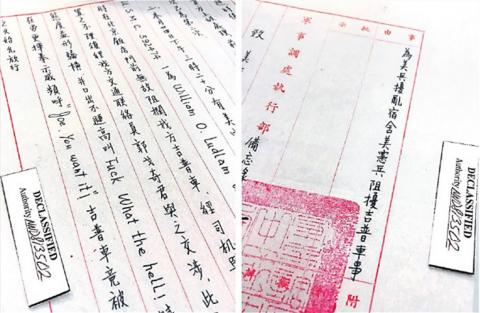A group of US-based activists has started searching the official archives of the US government and the UN for Taiwanese historical materials to publish them for free on the Internet.
Technology is the centerpiece of the project, as the software the group is developing would enable volunteers to scan and upload historical documents with their mobile devices, Lin Yu-Cheng (林育正), a project leader and a self-styled house-husband, said on Sunday.
Funded via the Web-based transparency activism platform G0V and other private sources, the Taiwan National Treasure initiative was formally launched at the New York G0V Hackathon event in September last year.

Photo courtesy of Taiwan National Treasure
The initiative uses Facebook — via the page Taiwan National Treasure (國家寶藏) — to communicate with volunteers and donors.
The aim of the project is help Taiwanese gain a better understanding of their history by seeing the nation from the perspective of foreign governments through primary-source documents, Lin said.
The project’s leaders include tech entrepreneur Hsiao Hsin-cheng (蕭新晟) and assistant research professor of pharmacology at State University of New York Downstate Medical Center Abraham Chuang (莊士杰).
Since most of the volunteers are US-based, they are focusing on the depositories of the US National Archives and Records and Administration (NARA) and the UN Archives and Management Section (ARMS), Lin said.
When asked to comment on the project, Chuang said he had friends were affected by the wansei controversy that erupted last year.
He was referring to Chen Hsuan-ju (陳宣儒), who falsely claimed Japanese ancestry to promote her 2014 book Wansei Back Home (灣生回家) — written using the nom de plume Mika Tanaka — and a resulting documentary about Japanese born in Taiwan during the Japanese colonial era.
“Following the incident, my friends in New York and I began to wonder about the veracity of Taiwanese history — from the colonial period to the lifting of martial law — as it is told to us by textbooks, popular titles and the media. Who are the interpreters of Taiwanese history? Should we trust them uncritically?” Chuang said.
The Taiwan National Treasure initiative is a long-term project aimed at collecting important historical documents about Taiwan that are in foreign archives, guided by open data and democratic participation, he said.
Volunteers, including professional historians, have visited the National Archive in College Park, Maryland, in search of declassified documents about Taiwan, tens of millions of which are believed to be in the collection, he said.
The College Park depository, which is close to Washington, collects and stores documents flowing into the US government in the Washington area.
The records range from intelligence reports, records on Taiwan’s geography and hydrography and complications of statistics and surveys gathered from the Taiwanese media during the 1950s, to reports on Taiwanese literary figures, he said.
While some documents might repeat familiar findings, more data must have derived from the original collection efforts by the US government that promise new insights into Taiwanese history, he said.
Some of the data is likely to diverge from the accounts of Taiwanese authorities or interpret events from an outside perspective, with assessments that are likely to be more objective at times, Chuang said.
A mobile app — described as a work in progress — is aimed at helping volunteers digitize documents and transform them into an open data resource, which would help other people and institutions who are researching Taiwanese history, he said.
Volunteers are making regular research trips to the National Archive and the UN ARMS office in New York, Chuang said.

SECURITY: As China is ‘reshaping’ Hong Kong’s population, Taiwan must raise the eligibility threshold for applications from Hong Kongers, Chiu Chui-cheng said When Hong Kong and Macau citizens apply for residency in Taiwan, it would be under a new category that includes a “national security observation period,” Mainland Affairs Council (MAC) Minister Chiu Chui-cheng (邱垂正) said yesterday. President William Lai (賴清德) on March 13 announced 17 strategies to counter China’s aggression toward Taiwan, including incorporating national security considerations into the review process for residency applications from Hong Kong and Macau citizens. The situation in Hong Kong is constantly changing, Chiu said to media yesterday on the sidelines of the Taipei Technology Run hosted by the Taipei Neihu Technology Park Development Association. With

CARROT AND STICK: While unrelenting in its military threats, China attracted nearly 40,000 Taiwanese to over 400 business events last year Nearly 40,000 Taiwanese last year joined industry events in China, such as conferences and trade fairs, supported by the Chinese government, a study showed yesterday, as Beijing ramps up a charm offensive toward Taipei alongside military pressure. China has long taken a carrot-and-stick approach to Taiwan, threatening it with the prospect of military action while reaching out to those it believes are amenable to Beijing’s point of view. Taiwanese security officials are wary of what they see as Beijing’s influence campaigns to sway public opinion after Taipei and Beijing gradually resumed travel links halted by the COVID-19 pandemic, but the scale of

A US Marine Corps regiment equipped with Naval Strike Missiles (NSM) is set to participate in the upcoming Balikatan 25 exercise in the Luzon Strait, marking the system’s first-ever deployment in the Philippines. US and Philippine officials have separately confirmed that the Navy Marine Expeditionary Ship Interdiction System (NMESIS) — the mobile launch platform for the Naval Strike Missile — would take part in the joint exercise. The missiles are being deployed to “a strategic first island chain chokepoint” in the waters between Taiwan proper and the Philippines, US-based Naval News reported. “The Luzon Strait and Bashi Channel represent a critical access

Pope Francis is be laid to rest on Saturday after lying in state for three days in St Peter’s Basilica, where the faithful are expected to flock to pay their respects to history’s first Latin American pontiff. The cardinals met yesterday in the Vatican’s synod hall to chart the next steps before a conclave begins to choose Francis’ successor, as condolences poured in from around the world. According to current norms, the conclave must begin between May 5 and 10. The cardinals set the funeral for Saturday at 10am in St Peter’s Square, to be celebrated by the dean of the College